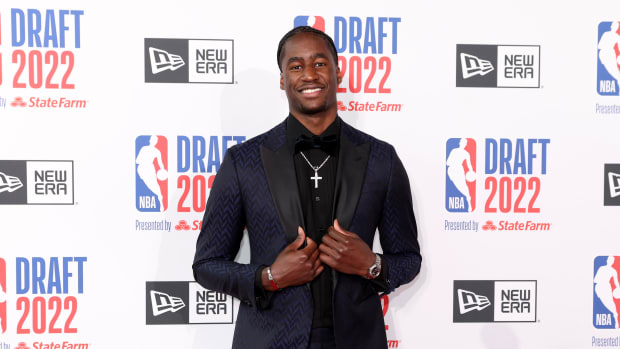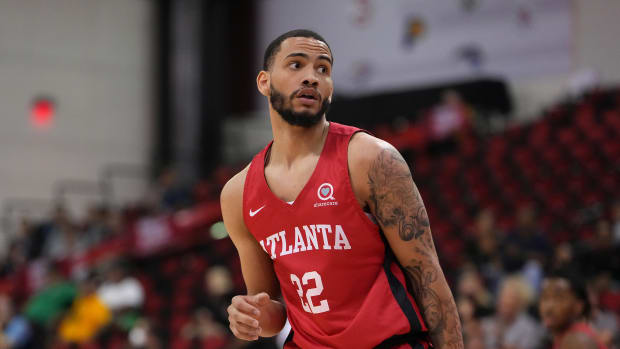Grading Atlanta Hawks 2022 NBA Draft Picks

This year in the 2022 NBA Draft, the Atlanta Hawks were granted the opportunity to add two bright starlets to their roster to propel their franchise in the right direction.
Though the Draft is always filled with plenty of promising talent, the inevitable reality is that not everyone on the board will be able to achieve the same level of greatness and success as some of their other classmates. And determining which diamond in the rough has the greatest potential to be something special will shape a team's future, for better or worse.
In the first round, the Hawks drafted Duke forward AJ Griffin with their 16th overall pick, a freshman who illustrated signs of stardom during his sole season in college. Later in the second round, the Hawks chose to complete a trade with the Golden State Warriors, swapping their 44th overall pick (Ryan Rollins) for the Warriors' 51st, which led the Hawks to receive UConn guard Tyrese Martin.
However, the biggest question for the Hawks since Draft Night is whether these two players were the best options they could have picked for their rotation? From their potential roles, strengths, weaknesses, and first-year impact, we will assess what grades are worthy for each of these selections and what Hawks fans can expect from their two rookies.
Without further ado, here are the 2022 NBA Draft Grades for each Hawks rookie.
Hawks Draft Grades
AJ Griffin

Round 1 (Pick 16 Overall): SF AJ Griffin – Duke
Draft Pick Grade: B
When the Hawks drafted Griffin in the first round, they addressed some of their crucial needs, but by no means everything they could have had they selected a different player.
Griffin's greatest strength is his scoring efficiency from all over the floor. To go along with his 6’6”, 222-pound frame that allows him to penetrate and slash inside quite well, Griffin is very in tune with his shooting touch and shot selection, leading him to finish his sole season at Duke with a 49.3 field goal percentage to go with a 44.7% average from behind the arc as well. Because he possesses great physicality, strength, and athleticism, Griffin creates space for himself with ease and is a powerful finisher when attacking the rim.
"Super exciting kid, I think all the fans should be happy."
— Atlanta Hawks (@ATLHawks) June 24, 2022
GM Landry Fields on AJ Griffin: pic.twitter.com/VJasaFW9mk
That said, the reason why Griffin receives a B grade in my book predominantly comes down to his lack of versatility as a playmaker, his spotty defense, and his unrefined areas that could take 2-3 years to develop, if not longer. There’s a lot here but let’s break down the specifics.
First and foremost, when Griffin was playing at Duke alongside Paolo Banchero, Mark Williams, and Wendell Moore, his scoring wasn’t always needed to win games, which frequently exposed the minimal productivity Griffin would display in other areas. In 39 games played (24 minutes per game), Griffin only averaged 3.9 rebounds and 1 assist. In fact, Griffin only had four games where he recorded seven rebounds or more on the season, illustrating a big gap in his potential playmaking ability when he isn’t tasked with scoring the ball. This is something for the Hawks to keep an eye on, particularly since they have plenty of scorers who can get the job done on any night, to begin with, aside from Griffin.
Secondly, Griffin has shaky defense that has been a work-in-progress. Because of his size and bulkiness, Griffin doesn’t have great footwork and can be a little cumbersome to react defensively. Throughout all 39 games he played this season, Griffin averaged 0.6 blocks and 0.5 steals per game, which will have to change if he intends to maximize his potential as a two-way forward in the NBA.
Pen to paper ✍️
— Atlanta Hawks (@ATLHawks) July 3, 2022
We've officially signed @whoisAG21: https://t.co/n3abIap0VB pic.twitter.com/TvBIbQx0eb
Lastly, because he’s so young (Griffin is turning 19 on August 25th) and only played a single season in college, Griffin will take a couple of years at the minimum to really come into his own and refine his growing skillset. Whether it’s his willingness to pass more, to his familiarity of how aggressive to be as a scorer and when, to getting acquainted with his spots, to sharpening his defensive influence, Griffin still has a lot to improve. And seeing how stacked the Hawks lineup already is, he could take some time to really become the star people have projected him to be.
As a result of their deep roster, it’s difficult to fathom Griffin being much more than a key scorer off the bench the Hawks will bring in when resting their starters. Whether the Hawks play big and slot him in at the two or have him come in at the three, Griffin has the potential to be the valuable catch-and-shoot asset and mid-range assassin that the Hawks could plug in when they need a scoring boost. It’s hard to see Griffin being a part of the Rookie of the Year conversations. But you can expect him to bring an uplifting scoring attack that will spread the floor for a dangerous Hawks offense.
Tyrese Martin

Round 2 (Pick 51 Overall): SG/SF Tyrese Martin – UConn
Draft Pick Grade: C+
After selecting Griffin 16th overall in the first round, the Hawks decided to trade for guard Tyrese Martin out of UConn in the second, who not only has a similar stature to that of Griffin but who also possesses a handful of comparable strengths with the Duke forward as well.
Standing at 6’6” and 215 pounds, Martin is an athletic, physical player with speed and excellent bounce that allows him to play above the rim. Furthermore, Martin really improved into a great sharpshooter from behind the arc in his final collegiate season. After posting 31.7% from 3PT range in his first three years in college, Martin shot a stellar 43% from behind the arc despite taking 3.4 3PT attempts per game, the second highest average of his collegiate career.
.@resemartin4 put on his own show in Vegas 💥 pic.twitter.com/8TZiFkUJix
— Atlanta Hawks (@ATLHawks) July 16, 2022
That said, Martin does have a pair of unique strengths that Griffin doesn’t have just yet that could prove to be very beneficial for the Hawks this season. For starters, Martin was one of the best rebounding guards in the country, particularly when creating second chance opportunities with his offensive rebounding. In all 29 games he started, Martin averaged 7.5 rebounds (8.4 per 36 mins), which included 2.3 offensive boards per game. From his anticipation to his awareness, Martin could provide a big rebounding boost for the Hawks this season.
In addition, Martin brings the perimeter defense the Hawks have been in desperate need of. Although Martin doesn’t possess great length as a defender (he has just a 6’8” wingspan), he compensates for it with his elite strength as an on-ball defender, sharp quickness, high motor, and imposing physicality. Over his four-year collegiate career, Martin posted just 0.4 blocks to go with 0.9 steals, illustrating how his lack of length has impacted his success on both those fronts. But his tenacity and tight defensive presence have led him to become a versatile, two-way player that can guard the one through three and even smaller fours.
OFFICIAL: We have signed rookie Tyrese Martin to a multi-year contract
— Atlanta Hawks (@ATLHawks) July 16, 2022
More ⬇️ https://t.co/T2pR9dyEaz
As for his passing, Martin did display his best season to date as well, nearly recording 2.0 assists per game (another collegiate career high). But if he aims to space the floor and maximize his influence as an offensive threat in the NBA, Martin will need to become a better passer, particularly once defenses recognize his scoring patterns.
In short, Martin could be a great asset off the bench, particularly when the Hawks need to clamp down defensively and open the floor with three-point shooting and transition offense. But because the Hawks have a pretty stacked rotation, Martin will probably have a small role that might garner no more than 15 minutes per game this season.
Recommended For You
Should Lou Williams Retire? No.
